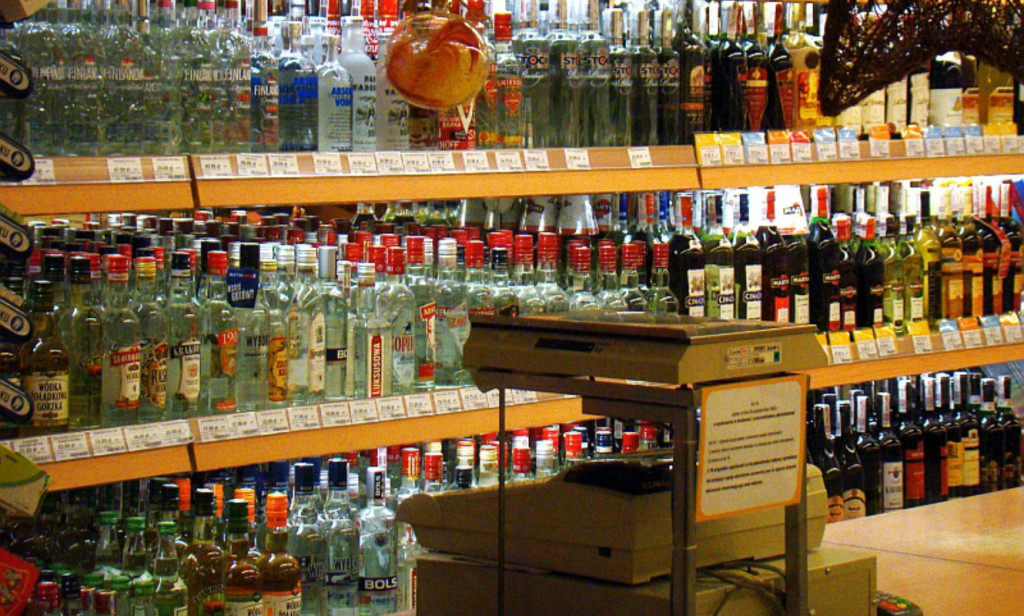

In my house, in my cousin’s house, in my grandfather’s house in Moscow, and even in my sister’s one-room apartment in Bed-Stuy sits a sealed bottle of vodka. Unlike the vodka spoiling countless quantities of juice, cocktails, and brain cells on a weekend in Washington, D.C., this vodka defines luxury and exclusivity. Moreover, this vodka sits in a box, waiting for a special occasion when its one-of-a-kind depth of flavorless clear liquid can be shared with the world. Believe you me, this vodka is premium.
How do I know? The label says so.
Though we may scoff at some of the more ridiculous labels commonly found in our liquor stores, the manner in which vodka is advertised in Russia is serious business. And for good reason. First and foremost, whereas most other alcohols each have a distinct flavor (and thus a real point of distinction from their competitors), vodka is relatively the same across the board. Sure, the use of grapes, potatoes, or wheat during mashing, fermenting, distillation, and rectification may suggest perceptible differences, but in the end, vodka, regardless of base ingredient, is flavor-neutral, astringent, and one-dimensional. This is the crux of why labels play such an important role in attracting customers; instead of discernible flavor, consumers seek discernible labels. When you consider annual vodka consumption in Russia is still 13.5 liters per capita (down from a whopping 18 liters per capita in 2010–2011), vodka (and the way it’s labeled) makes for big business.
In much the same way that a well-designed wine label has been proven to make “a good wine more desirable and a bad wine more salable,” vodka labels in Russia have developed to suggest quality where there is none. Prior to the collapse of the Soviet Union in 1991, the appearance of vodka labels was an afterthought — production was in the hands of the state and consumers paid no heed to the labels adorning their bottles. But after 1991, like much of Russia, this changed almost immediately. Labels began to try to capture the mood of post-Soviet Russia in an attempt to instill feelings of familiarity and comfort within the consumer. It was not uncommon to walk into a central Moscow grocery and see vodka bottles splashed with images of popular ‘90s Russian entertainers such as Mikhail Krug or of historical figures like Alexander Pushkin.
Vodka labels in the 1990s also pandered to the widespread nostalgia for the Soviet Union within Russian society; some labels only consisted of the numbers 3.62 or 4.12, referencing the price of Soviet-era Moskovskaya vodka, which cost three rubles and 62 kopecks, and Stolichnaya vodka, which cost four rubles and 12 kopecks.
As Russia began to move past the turmoil of the 1990s, so did vodka labels. Modernization took hold, memories of the doom-and-gloom 1990s were replaced with realities of the oil-sponsored economic growth of the 2000s, and drab vodka bottle labels were replaced with slick, bright imagery. More importantly, vodka labels began to support domestic narratives that continue to be promoted by the Kremlin — nationalism, patriotism, and a heightened sense of self-worth. For example, vodkas like “Russian Wheat” used simple, colorful labels that portrayed golden wheat fields, bright sun, and blue sky.
The effectiveness of vodka labels — measured strictly in sales — is hard to measure. As mentioned previously, consumption of vodka is down throughout Russia. But if we move beyond sales and focus instead on federal government action, then it is clear vodka labels are striking the proper chord with the Russian consumer. On July 13, 2015, at a hearing of the Public Chamber of the Russian Federation, representatives of the Ministry of Health and the Council for the Protection of Russian Citizens from Drugs, Alcohol, and Tobacco Dependence proposed a new labeling standard requiring all alcoholic beverages to have minimal information about the brand, manufacturer, and ingredient composition featured on the label. Additionally, this information would have to be published using a government-dictated standardized font.
Sultan Hamzaev, director of the Council for the Protection of Russian Citizens from Drugs, Alcohol, and Tobacco Dependence, defended the proposed new standard: “The more government is engaged in the prevention of alcohol abuse, the more aggressively alcohol companies promote their products,“ adding that “bright labels, in themselves, motivate alcohol purchases by citizens.”
Vodka, and the manner in which it is advertised, will always be an issue in Russia. Vodka production, especially when illegal production is taken into account, is still high, despite the growing popularity of beer. Despite this, vodka labels play a role that extends beyond simple market economics. Rather, vodka labels in Russia play an almost existential role within the minds of the consumer. They exist, in part, to aggrandize the consumer and to create a lasting perception that an insignificant alcoholic beverage can be something much more.
Vodka is ingrained in the Russian psyche — it plays an unenviable dichotomous role as a symbol of both Russian pride and Russian peril. The symbolism with which it is marketed latches onto the former, drawing in consumers who only need the slightest push. And yet, despite all of this, consumers embrace it. The number of “one-of-a-kind” vodkas dispersed amongst my family is a testament to that. Whether or not the spirit in those boxes is worth drinking is anyone’s guess — but it’s something we accept as uniquely ours, to save for the next special occasion.
Ruben Gzirian is a pursuer of fine whiskeys, with Michter’s US*1 American Whiskey currently his favorite. He holds an MA from the Monterey Institute of International Studies and enjoys reading World War II history, with a focus on the Eastern Front.
Photo credit: Silar
